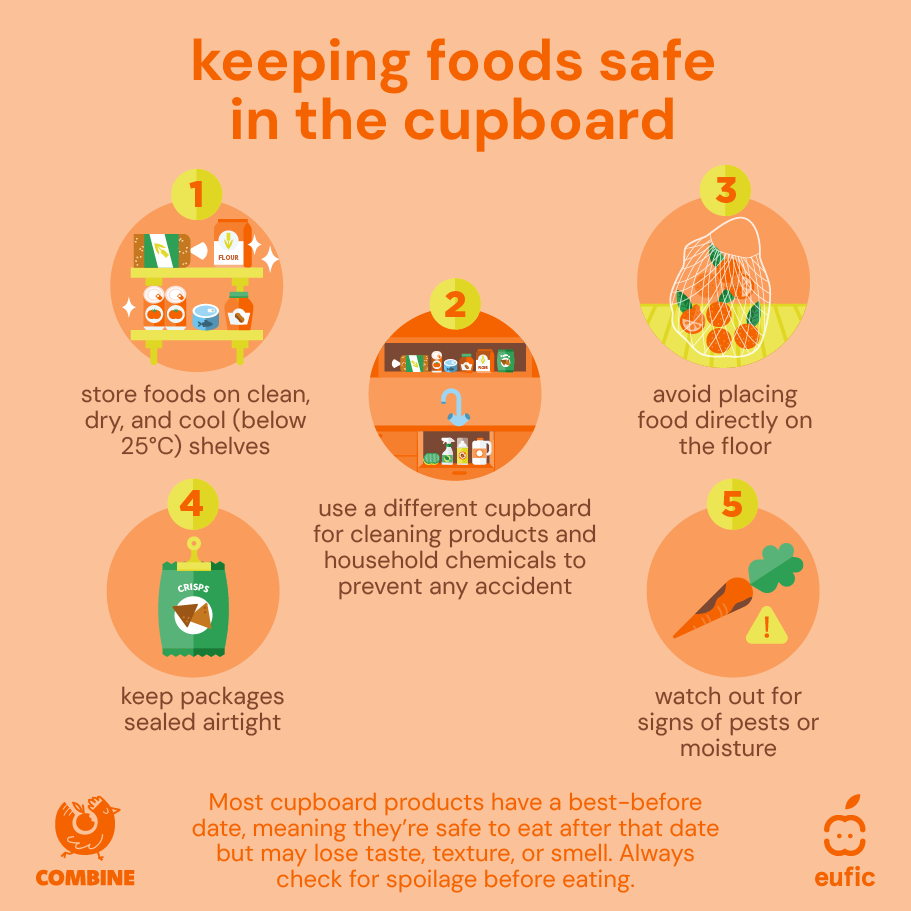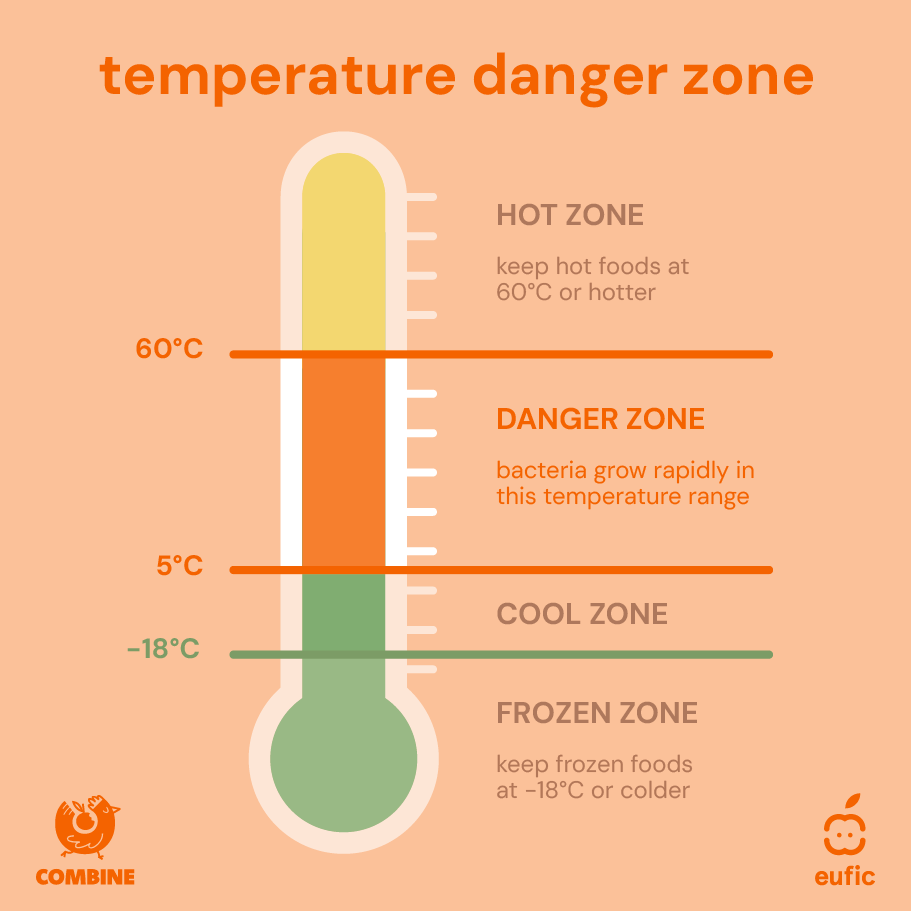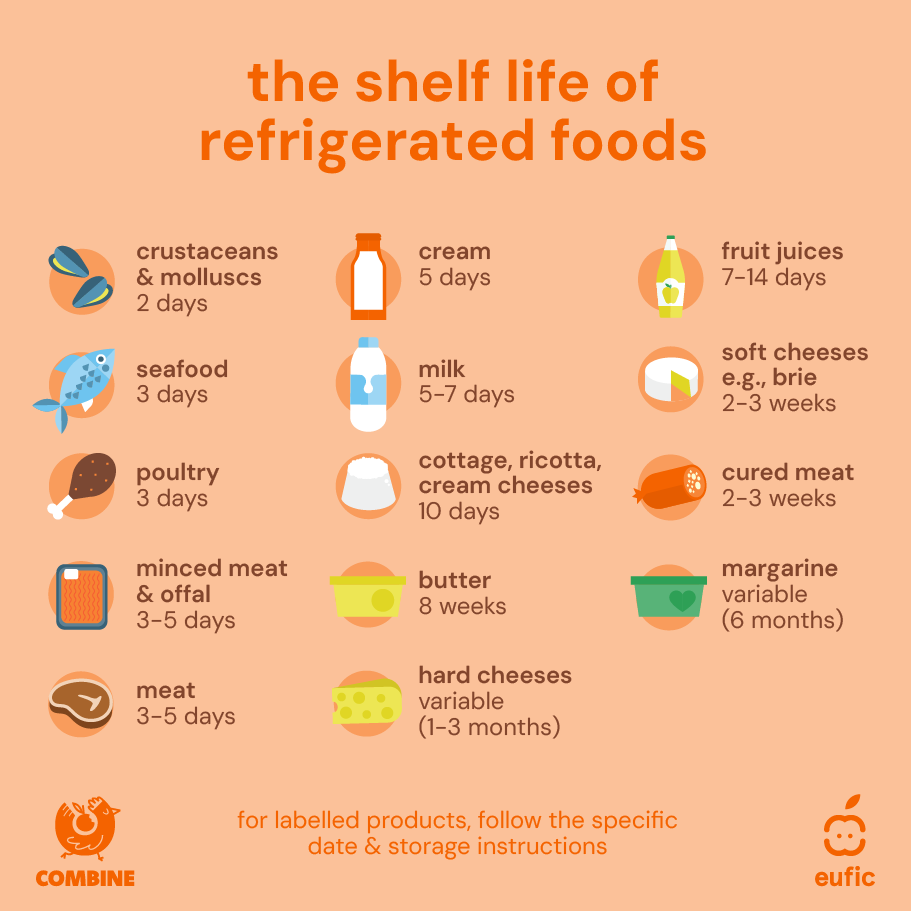How to properly store food in the fridge, freezer and cupboard
Last Updated : 19 November 2025Key takeaways:
- Storing foods correctly in the fridge, freezer, and cupboard helps to keep them safe, fresh, and flavourful for longer, while reducing food waste.
- Keep your fridge at maximum 4°C, avoid overcrowding, cool down warm meals to room temperature before storing them within 2 hours, keep raw and cooked items separately, clean spills promptly, and eat perishable foods and leftovers within recommended timeframes to ensure safety and reduce food waste.
- Keep your freezer at or below –18°C using proper packaging, avoid freezing hot foods, thaw completely before cooking (preferably in the fridge), never refreeze thawed food unless cooked, and cook immediately after microwave defrosting to ensure safety and maintain quality.
- Freezing preserves most nutrients in foods, often keeping fruits, vegetables, and meats as nutritious as fresh produce, by halting nutrient loss and cellular activity. Only minor reductions occur in some sensitive vitamins during blanching or if defrosting liquids are discarded.
- Most foods, including fruits, vegetables, meats, poultry, cooked dishes, and pulses, can be safely frozen. High-water-content foods (like lettuce, cucumbers, tomatoes) and high-fat or cream-based items (like mayonnaise or custards) may lose texture or separate and are best not frozen.
Properly storing food is key to keeping it safe, fresh, and flavourful for longer. Not only does this reduce the risk of illness, but it also helps us cut down on food waste and save money. Understanding where and how to store different foods, whether in the fridge, freezer, or cupboard, can make a big difference. The following storage guidelines will help you make the most of your groceries, prevent spoilage, and look after both your health and the environment.
Cupboard storage
Clean, dry and cool (below 25°C) shelves are the best place to store bread, dry food (in sealed bags or containers), unopened tins, jars and drinks.
Some produce, particularly those from the tropics, such as bananas, are sensitive to cold, and should not be stored in the refrigerator. Potatoes and onions are best stored outside the refrigerator in a dark place to avoid sprouting. Produce that needs ripening, such as tomatoes, avocados, stone fruit and pears can be ripened by storing at room temperature, away from direct sunlight.1
Make sure not to place food directly on the floor to avoid attracting insects and rodents,2and use a different cupboard for cleaning products and household chemicals to prevent any accident contaminating the food.3
Learn more about which foods should be stored in the cupboard or in the fridge here.

Fig. 1 – Keeping foods safe in the cupboard.
Which foods should be refrigerated?
Foods labelled with ‘keep refrigerated’ and most foods with a ‘use by’ date, such as pasteurised milk, meat, ready meals, etc., should be kept in the fridge so they stay safe until the use by date given on the label. The cool temperature (at a maximum of 4°C) slows down the growth of harmful microbes. Food items stored between 5°C and 60°C provide an optimal environment for bacteria and other microorganisms to grow and spoil them. It’s recommended to cool down warm meals within two hours and immediately refrigerate them once they are at room temperature.
Some items, otherwise kept at room temperature, such as UHT milk, fruit juice or soup, must be refrigerated after opening. It’s best not to store opened tins in the fridge, as this may give the food a metallic taste. Transfer their contents into food containers and cover.

Fig. 2 – The temperature danger zone.
Refrigerating tips
To keep food safe and fresh for longer, follow these key tips for organising and maintaining your refrigerator.4,5
- Keep the fridge below 4°C and check regularly using a refrigerator thermometer.
- Avoid packing too much in your fridge. Allow space between items, so that air can circulate and the refrigerator can function efficiently.
- Avoid placing hot foods straight into the fridge as this will raise the temperature of the fridge. Wait till they cool down to room temperature.
- Remember the ‘2-hour rule’: whether it is leftover, take-away, or just-bought, it is important to cool and place foods in the fridge within 2 hours.
- Most foods with a ‘use by’ date (e.g., dairy, meat, ready meals, etc.) should be kept in the fridge.
- Store raw meat, fish and poultry in sealed containers, on the bottom shelf of your fridge. These raw foods can contain microbes that can cause illness. These microbes are killed during cooking, so it’s important to keep cooked and ready-to-eat foods separated from raw foods, to stop microbes spreading.
- Microbes can still grow at low temperatures, although more slowly. So, it is best to wipe up spills immediately, clean the fridge frequently, and store foods wrapped or in covered containers.
- Eat leftovers within 2-3 days. Rice dishes should be used within 1 day, because rice can contain spores of Bacillus cereus that can survive cooking, and these can grow into bacteria. The longer cooked rice is kept, the more likely it is that the bacteria will make it unsafe to eat.
- Keep foods that need to be used soon in the front or have a section in the fridge where you store foods that could spoil soon, so you remember to eat them and avoid unnecessary food waste.

Fig. 3 – Guidance on shelf life of some chilled food, in the coldest part of a refrigerator.6
Is it good to freeze food?
Yes, freezing food is not only safe but also one of the best ways to preserve both its quality and nutritional value. By slowing down the growth of bacteria, yeasts, and moulds, freezing effectively pauses the natural processes that cause food spoilage. This means that fruits and vegetables, meats, and even cooked dishes can be kept for weeks or months without significant loss of flavour, texture, or nutrients. It also helps reduce food waste by allowing you to save leftovers or bulk purchases for later use.
You can freeze just about all foods before its 'use by' date and keep it safe. However, proper freezing techniques and storage are important to maintain food quality and safety. Beware that the quality will decrease after 3-12 months depending on the product, so always check the label instructions. While freezing won’t improve the freshness of food that is already spoiling, it’s an excellent way to lock in nutrients and flavour when done correctly.

Fig. 4 – The benefits of frozen fruits and vegetables.
How does freezing preserve food and keep it safe?
Freezing preserves food and keeps it safe by slowing down the processes that lead to spoilage. Most bacteria, yeasts, and moulds need water and warmth to grow. When food is frozen, the water inside it turns into ice crystals, making it unavailable for microbial activity. This halts the growth of harmful microorganisms that could cause foodborne illness. Freezing also slows down the action of natural enzymes found in food, which are responsible for changes in colour, flavour, and texture over time. While these enzymes are not destroyed by freezing, their activity is significantly reduced at temperatures below –18°C. Once food is thawed, these processes can resume, which is why it’s important to handle defrosted food carefully and avoid refreezing it.
Does freezing food kill bacteria?
No, freezing food does not kill bacteria but rather slows down their growth significantly. When the food is thawed, they can grow and multiply again. It is therefore important to handle and store food properly to prevent the risk of foodborne illness. This includes thawing frozen food completely before cooking, ideally in a container in the fridge overnight, cooking and eating the food straight away, and avoiding refreezing thawed food.
What effect does freezing have on the nutrient content of foods?
Freezing has very little effect on the nutrient content of foods. In fact, frozen fruits and vegetables are often just as nutritious, or even more so, than fresh produce that has spent days in transport and on store shelves. Produce is most nutritious at the point of harvest. Afterwards, fruits and vegetables begin to lose nutrients, particularly vitamin C, as they continue to use its own nutrients and break down their own stores of energy. Refrigeration slows this process, but freezing almost completely halts it by pausing oxidation and cellular activity. Vegetables and fruits are frozen in peak condition soon after harvesting and therefore retain their vitamin and mineral content.
Before freezing, many vegetables are briefly blanched (dipped in boiling water) to inactivate enzymes that would otherwise degrade colour and texture. This step can, however, cause small losses of sensitive vitamins such as vitamin C, some B vitamins, as well as antioxidants. For example, spinach can lose all its vitamin C within a week at room temperature; 75% if refrigerated, but only about 30% when frozen. Similarly, green peas lose 60% of their vitamin C content when stored for a week at room temperature, 15% if refrigerated, and only 10% when frozen.7 Other nutrients such as fat-soluble vitamins A and E are less likely to be lost during blanching. In some cases, mild processing steps like blanching or cooking can even make vegetables’ vitamins easier for our bodies to absorb as it breaks down their cells release nutrients that are otherwise ‘trapped’.8
As for meats, fish and poultry, freezing does not affect their protein, vitamin A or D, or mineral content, though some water-soluble vitamins may be lost if the defrosting liquid is discarded.
Can I freeze leftovers after 3 days?
It’s generally safe to freeze leftovers within three days, as long as they’ve been stored properly in the fridge during that time. The sooner you freeze them, however, the better the quality and safety will be. Bacteria multiply most rapidly at room temperature, so food should be cooled and refrigerated within two hours of cooking to reduce the risk of spoilage. If you decide to freeze your leftovers after a few days, make sure they still smell and look fresh before doing so. Once frozen, most leftovers can be safely kept for up to three months. When you’re ready to eat them, reheat the food thoroughly until it’s steaming hot all the way through. Should you still have something left over from the reheated leftovers, it is better to throw it away. So, do not heat it a second time and do not freeze it a second time either. Each cycle of cooling and warming gives bacteria more opportunity to grow, increasing the risk of foodborne illness.
What is the best way to freeze different foods?
Fruit
Almost any fruit can be frozen. Fruit will keep up to 6 months in the freezer. Grapes and berries like strawberries, raspberries, and blueberries can be frozen whole. Larger fruits like apples, pears, bananas and mango can be best sliced into smaller pieces first. To avoid clumping, spread pieces in a single layer on a tray, freeze them, then transfer to airtight containers or freezer bags. Citrus fruits like lemons, limes, or oranges can be frozen as slices or juice. You can use the frozen slices to spark up your water, but you can also use them as a garnish with fish or meat, for example. Many fruits like apples, pears, mango, apricots, berries, plums, and rhubarb can also be pureed first and then frozen in an ice cube tray or small container.
Vegetables
Blanch vegetables briefly in boiling water or steam before freezing to preserve their colour and texture. Cool them quickly in ice water, pat dry, and freeze in a single layer before transferring to airtight containers or freezer bags. Some vegetables like onions, peppers, and leeks don’t need blanching. Properly frozen vegetables can be stored for up to one year.
Bread
Freeze bread immediately after purchase. Keep it in its packaging or an airtight bag and defrost individual slices when needed. Bread keeps well for up to three months.
Fish
Most fish can be safely frozen for two to four months. Wrap tightly to avoid freezer burn and retain freshness.
Meat and poultry
The shelf life of meat in the freezer may differ: uncooked meat can be kept frozen for 4-12 months and uncooked poultry for 9-12 months. This reduces for already cooked meats: cooked meat can be stored for 2-3 months and cooked poultry for 4 months. Thaw and cook thoroughly before eating.
Pulses
Cooked beans, lentils, and chickpeas can be frozen in small portions and stored for up to three months.
What foods should not be frozen?
Not all foods freeze well, as the formation of ice crystals can damage their structure and affect their texture once thawed. When food freezes slowly, large ice crystals form and break the cell membranes inside, leading to soggy or mushy textures after defrosting. This doesn’t make the food unsafe to eat, but it can reduce its quality and appeal. Foods with high water content, such as lettuce, cucumbers, tomatoes, mushrooms, and soft fruits, tend to lose their crispness and become watery when thawed. Similarly, foods with a high fat content, like cream-based sauces, mayonnaise, or custards, can separate or curdle after freezing.
Commercially frozen foods usually fare better because they undergo rapid freezing, which forms much smaller ice crystals and helps preserve texture and flavour. At home, if you want to freeze food successfully, it’s best to choose items known to freeze well and use airtight packaging to minimise moisture loss and texture changes.
How long can food be kept in the freezer?
Foods can be safely kept in the home freezer for 3 to 12 months without loss of quality. Keeping times vary depending on the food and the product label provides the best indication of keeping time.

Fig. 5 - Guidance on how long foods will stay at their best quality in the freezer.9
What to do if the freezer stops working?
In case the freezer stops working (due to, for instance, a power cut), it is best to leave the food inside and keep the door shut. If the failure is repaired within 24 hours, foods will most likely remain frozen and safe.10 Still, check items individually, as food that has begun to defrost (starting to get soft and/or with liquid coming out) should be immediately used.11
Freezing tips
To keep frozen foods safe and in good condition, follow these freezer management tips.4
- Keep the freezer at or below -18°C, check with a thermometer.
- Use appropriate packaging (sealed freezer bags and plastic containers) to help protect foods and prevent ‘freezer burn’.
- Thaw frozen food completely before cooking, ideally in a container in the fridge overnight. Once cooked, it can be stored in the fridge for 2-3 days.
- Do not refreeze thawed food. Food that has been defrosted should never be refrozen unless it is cooked prior to refreezing.
- Avoid placing hot foods straight into the freezer, as this will raise the temperature in the freezer.
- Food can also be defrosted in the microwave. However, microwaves can heat unevenly, and leave ‘cold’ and ‘warm’ spots where microbes can survive. Therefore, once fully defrosted in the microwave, it’s best to cook and eat the food straight away.
The COMBINE project: A unified approach to reducing food waste
The COMBINE project is an EU-funded initiative (2024–2026) working to cut consumer food waste by at least 30% in schools, homes, and workplace canteens across Portugal, France, Italy, and Finland. By combining education, behavioural nudges, and practical tools, COMBINE helps people make better food choices, waste less, and protect the planet.
Conclusion
Proper food storage is one of the simplest and most effective ways to stay healthy, reduce waste, and save money. Whether keeping dry goods in a cool cupboard, maintaining a clean and organised fridge, or using the freezer wisely, small everyday actions can make a big difference. By understanding how to store different foods safely, we not only protect our health but also contribute to a more sustainable food system
The article was developed in collaboration with the COMBINE project. This project has received funding from the European Union’s Single Market Programme Food Chain under grant agreement N° 101158394.

References
- Singh, Yogendra & Bhatnagar, Prerak & Kumar, Yogendra & Gurjar, Suresh. (2020). Chapter -6 A Peep into Insight of Physiological Disorders of Fruits and Their Management Remedies Chapter -6 A Peep into Insight of Physiological Disorders of Fruits and The
- FAO. 2023. Establishment maintenance, disinfection and pest control – Section 5. FAO Good Hygiene Practices (GHP) and Hazard Analysis and Critical Control Point (HACCP) Toolbox for Food Safety. Rome.
- Rather IA, Koh WY, Paek WK and Lim J (2017) The Sources of Chemical Contaminants in Food and Their Health Implications. Front. Pharmacol. 8:830. doi: 10.3389/fphar.2017.00830
- Food Safety Authority of Ireland, Storing food safely. Accessed 20 October 2025
- Safefood, Keeping food safe in your fridge. Accessed 20 October 2025
- CSIRO, Refrigerated storage of perishable foods. Accessed 20 October 2025
- Rickman JC, Barrett DM & Bruhn CM. (2007). Nutritional comparison of fresh, frozen and canned fruits and vegetables. Part I. Vitamins C and B and phenolic compounds. Journal of the Science of Food and Agriculture 87:930-944.
- Rickman JC, Barrett DM & Bruhn CM. (2007). Nutritional comparison of fresh, frozen and canned fruits and vegetables. Part II. Vitamin A and carotenoids, vitamin E, minerals and fiber. Journal of the Science of Food and Agriculture 87:1185-1196
- Safefood, Storing food in the freezer. Accessed on 20 October 2025
- Food Standard Agency, Food safety in a power cut - advice for consumers. Last updated on 17 September 2025
- Food Standard Agency, Safe catering. Last updated on 03 May 2022